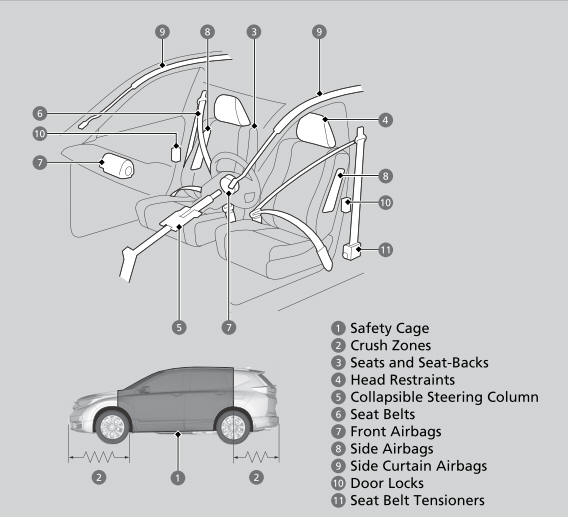Honda CR-V: Refueling / How to Refuel
Your fuel tank is not equipped with a fuel filler cap. You can insert the filler nozzle directly into the filler neck. The tank seals itself again when you pull out the filler nozzle.
- Stop your vehicle with the service station pump on the left side of the vehicle in the rear.
- Turn off the engine.
- Pull on the fuel fill door release handle
under the lower left corner of the
dashboard.
- The fuel fill door opens.

- Place the end of the filler nozzle on the
lower part of filler opening, then insert it
slowly and fully.
- Make sure that the end of the filler nozzle goes down along with the filler pipe.
- Keep the filler nozzle level.
- When the tank is full, the filler nozzle will click off automatically.
- After filling, wait about five seconds before removing the filler nozzle.
- Shut the fuel fill door by hand.

WARNING
Gasoline is highly flammable and explosive. You can be burned or seriously injured when handling fuel.
- Stop the engine, and keep heat, sparks, and flame away.
- Handle fuel only outdoors.
- Wipe up spills immediately.
The fuel filler opening is designed to accept only service station filler nozzles for refueling. Use of smaller diameter tubes (e.g., those used to siphon fuel for other uses) or other non-service station devices can damage the area in and around the filler opening.
The filler nozzle automatically stops to leave space in the fuel tank so that fuel does not overflow as a result of changes in air temperature.
Do not continue to add fuel after the filler nozzle has automatically stopped. Additional fuel can exceed the full tank capacity.
If the filler nozzle keeps turning off when the tank is not full, there may be a problem with the pump's fuel vapor recovery system. Try filling at another pump. If this does not fix the problem, consult a dealer.
If you have to refuel your vehicle from a portable container, use the funnel provided with your vehicle.
 Fuel Information
Fuel Information
Fuel recommendation
Unleaded gasoline, pump octane number 87 or higher
Use of lower octane gasoline can cause a persistent, heavy metallic knocking
noise
that can lead to engine damage...
 Fuel Economy and CO2 Emissions
Fuel Economy and CO2 Emissions
Improving Fuel Economy and Reducing CO2 Emissions
Achieving fuel economy and reducing CO2
emissions is dependent on several
factors, including driving conditions, load weight, idling time, driving habits,
and
vehicle condition...
Other information:
Honda CR-V 2017-2024 Owner's Manual: Airbag Care
You do not need to, and should not, perform any maintenance on or replace any airbag system components yourself. However, you should have your vehicle inspected by a dealer in the following situations: When the airbags have deployed If an airbag has inflated, the control unit and other related parts must be replaced...
Honda CR-V 2017-2024 Owner's Manual: If the Low Tire Pressure/TPMS Indicator Comes On or Blinks
Reasons for the indicator to come on or blink A tire pressure is significantly low, or the TPMS has not been calibrated. If there is a problem with the TPMS or the compact spare tire is installed, the indicator blinks for about one minute, and then stays on...
Categories
- Manuals Home
- Honda CR-V Owners Manual
- Honda CR-V Service Manual
- Rear Seats
- Locking/Unlocking the Doors Using a Key
- Compass Zone Selection
- New on site
- Most important about car
Your Vehicle's Safety Features

The following checklist will help you take an active role in protecting yourself and your passengers.
Your vehicle is equipped with many features that work together to help protect you and your passengers during a crash.
